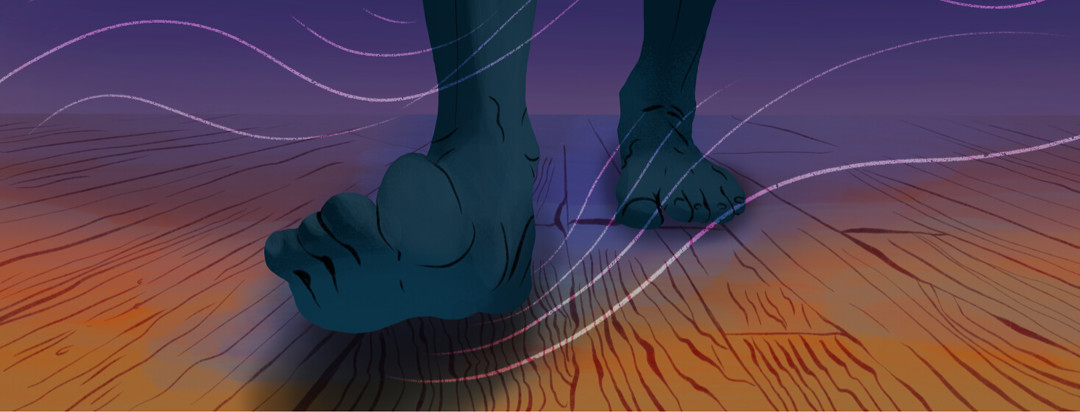The Safety Concerns of Sleepwalking and RBD in Parkinson's Disease
Your loved one with Parkinson’s disease (PD) sleeps at night, just not in their bed…they get up, walk around, perform small—or large!—tasks while clearly asleep.
Does this sound familiar?
This describes two sleep disorders: sleepwalking and REM sleep behavior disorder (RBD).1 In either case, these disorders—known collectively as parasomnias—can be both curious and amusing. But let’s not gloss over the real concern here: they can also be dangerous to everyone in the household.
What are parasomnias?
The Cleveland Clinic describes them as “disruptive sleep disorders that can occur during arousals from rapid eye movement (REM) sleep or arousals from non-rapid eye movement (NREM) sleep. They can result in undesirable physical or verbal behaviors, such as walking or talking during sleep. Parasomnias occur in association with sleep, specific stages of sleep, or sleep-wake transitions. These parasomnias can be disruptive to both the patient and the bed partner.”2
Parasomnias that take place during NREM sleep include sleepwalking, night terrors, and confusion arousals. Those that happen during REM sleep include nightmares, sleep paralysis, and RBD.
Some behaviors may also take place in both REM and NREM stages. For instance, sleep-related eating disorder (SRED)3 and bedwetting are two that most often occur during nonREM sleep but could happen during REM if inspired by dream content.
What might people with these disorders do during sleep? Here are a few possibilities:4
- Walking, dancing, running, other whole-body movements
- Eating, cooking
- Urinating, masturbating
- Singing, crying, talking, laughing, screaming, shouting
- Driving, criminal behavior
Parasomnias linked to PD
The sleep disorder most clinically linked to PD is RBD. It can resemble sleepwalking but isn’t the same thing.
"We don't know why RBD and PD are linked," says Dr. Mark Mahowald, the world-recognized sleep researcher who began studying RBD in 1985.5 "There is an obvious relationship, as about 40% of individuals who present with RBD without any signs or symptoms of PD will eventually go on to develop PD."
Sleep staging matters: During normal REM (dream) sleep, the body should undergo a temporary state of paralysis. In RBD, that paralysis safeguard doesn’t exist. This clinically differentiates RBD from sleepwalking, usually through a sleep study.
That said, a person with PD could experience both RBD and sleepwalking.
Here’s a closer look at both:
REM sleep behavior disorder (RBD)
RBD occurs during REM sleep. Dream enactment is this disorder’s hallmark trait. Dreams can happen in any sleep stage, but they most often occur (or are most compelling) in REM sleep.6 The person with RBD physically acts out the content of dreams, which can be violent or physical.7 They typically remember their dream content upon awakening.
Sleepwalking
Also known as somnambulism, it occurs during nonREM sleep, usually during deep stage 2 sleep. Sleepwalking occurs mostly during the first half of the night. It involves unusual movements unrelated to dream content. Their eyes may be wide open. Sleepwalkers generally don’t remember their actions; if they awaken during an episode, they’ll express confusion, return to bed and fall back to sleep.
Safety first!
Whether awake or asleep, anyone with PD who wanders at night becomes a fall risk.
Another problem? The nature of their movement. It’s impossible to know just what they’re dreaming about. If they’re enacting the running of a race, fighting off a predator, or jumping into a pool, just imagine how that physical behavior might threaten not only their safety but the safety and well-being of you and others in the household.
Still unsure? I recommend the film, Sleepwalk With Me, available for free on both Netflix and Amazon Prime. It features comedian Mike Birbiglia, who tells the true story of his experiences with RBD. His story clearly demonstrates what you can risk if you don’t address and treat RBD.
Tips to stay safe
- It’s not normal to enact dreams or sleepwalk regularly. Please discuss these behaviors with both your loved one and their PD specialist. Luckily the disorder is treatable.5
- Safety-proofing helps. Declutter, soften the sharp edges and corners of furniture, remove breakable items, fix throw rugs firmly to the floor, rearrange furniture, hide electrical cords, install stairwell gates, lock windows, and hide weapons.
- Take away or hide keys to vehicles.
- Install a door alarm if your loved one tends to wander (awake or asleep).
- Don’t be ashamed to find alternative sleeping quarters.
- Use a camera and monitor to watch your loved one if they’re in another room (baby nursery cams can do the job).
- Don't be afraid to awaken them, but be safe, especially if they're violent, exceptionally physical, or emotional. They're at higher risk for injury to themselves and others if left alone.8
Granted, these behaviors are unpredictable, and you can only do so much, but if it’s in the best interest of safety for an entire household, it’s well worth the effort.

Join the conversation